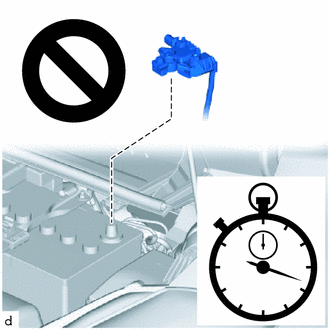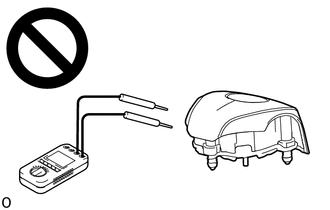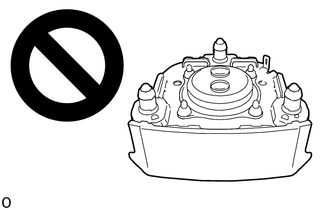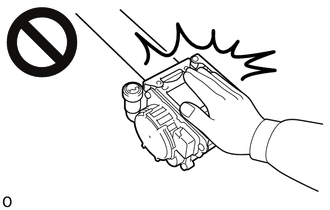| Last Modified: 01-30-2024 | 6.11:8.1.0 | Doc ID: RM100000001HI93 |
| Model Year Start: 2019 | Model: RAV4 | Prod Date Range: [02/2019 - 08/2020] |
| Title: SUPPLEMENTAL RESTRAINT SYSTEMS: AIRBAG SYSTEM (w/ Occupant Classification System): PRECAUTION; 2019 - 2020 MY RAV4 RAV4 HV [02/2019 - 08/2020] | ||
PRECAUTION
CAUTION:
- Failure to carry out service procedures in the correct sequence could cause SRS parts to unexpectedly deploy and possibly lead to serious injuries. Furthermore, if a mistake is made when servicing SRS parts, they may fail to operate when required. Before performing servicing (including installation/removal, inspection and replacement of parts), be sure to read the following precautions.
-
Be sure to perform initialization of the occupant detection ECU under any of the following conditions. If initialization is not performed, the SRS may not operate properly.
- The occupant detection ECU is replaced.
- Accessories (seatback tray, seat cover, etc.) are installed to the vehicle.
- The passenger seat is removed from the vehicle, and then reinstalled or replaced.
- The passenger airbag ON/OFF indicator light (OFF) comes on when the passenger seat is not occupied.
- The vehicle is brought to a workshop for repair due to an accident or collision.
(a) Furthermore, if a mistake is made when servicing SRS parts, they may fail to operate when required. Before performing servicing (including installation/removal, inspection and replacement of parts), be sure to read the following precautions.
- Airbag ECU assembly
- Occupant detection ECU
- Front airbag sensor
- Side airbag pressure sensor
- Floor side airbag sensor
- No. 2 side airbag sensor assembly
- Front seat adjuster assembly LH (Seat position airbag sensor)
- Front seat inner belt assembly
- Horn button assembly
- Instrument panel passenger without door airbag assembly
- Lower No. 1 instrument panel airbag assembly
- Front seat airbag assembly
- Curtain shield airbag assembly
- Front seat cushion airbag assembly
- Front seat outer belt assembly
PRECAUTION FOR DISCONNECTING CABLE FROM NEGATIVE AUXILIARY BATTERY TERMINAL
(a) When troubleshooting the SRS, always check for DTCs before disconnecting the cable from the negative (-) auxiliary battery terminal.
(b) After turning the ignition switch off, disconnect the cable from the negative (-) auxiliary battery terminal.
NOTICE:
After turning the ignition switch off, waiting time may be required before disconnecting the cable from the negative (-) auxiliary battery terminal.
HINT:
When disconnecting the cable from the negative (-) auxiliary battery terminal while performing repairs, some systems need to be initialized after the cable is reconnected.
(c) Work must be started at least 90 seconds after the ignition switch is turned off and the cable is disconnected from the negative (-) auxiliary battery terminal.
CAUTION:
The SRS is equipped with a back-up power source. If work is started within 90 seconds of disconnecting the cable from the negative (-) auxiliary battery terminal, the SRS parts may deploy.

(d) When the cable is disconnected from the negative (-) auxiliary battery terminal, the memory of various systems will be cleared. Because of this, be sure to make a record of the contents memorized in each system before starting work. When work is finished, adjust each system to its previous state.
GENERAL PRECAUTION
(a) Information labels are attached to the SRS parts. Follow the instructions on the labels.
(b) Never disassemble or attempt to repair any of the SRS parts.
(c) If any of the SRS parts are dropped, or if any cracks, dents or other defects are found, replace them with new parts.
(d) Never use SRS parts from another vehicle. When replacing parts, use new parts.
(e) Do not expose any of the SRS parts directly to high temperatures or flames.
(f) If the vehicle has been involved in a minor collision where the SRS did not deploy, the SRS parts should be inspected before further use of the vehicle.
(g) Do not apply grease, detergent, oil or water to the SRS parts. If applied, immediately wipe it off with a dry cloth.
(h) When deploying or storing the SRS parts, avoid places with a high temperature (ambient temperature of 93°C [199°F] or higher for an airbag and 80°C [176°F] or higher for a pretensioner) and high humidity, and keep them away from electrical noise.
(i) Do not stack or place anything on top of the SRS parts.
CAUTION:
Dispose of the airbags according to the disposal procedures for each airbag.

(j) Never measure the resistance of the SRS parts.
CAUTION:
Never measure the resistance of the SRS parts because current from the tester may cause the SRS parts to deploy.

(k) Use a voltmeter/ohmmeter with high impedance (minimum = 10 kΩ) for troubleshooting electrical circuits.
(l) Be sure to check the SRS warning light and multi-information display after checking, removing and installing, or replacing the airbag and sensor.
PRECAUTION WHEN REPLACING AIRBAG ECU ASSEMBLY
(a) After replacing the airbag ECU assembly, refer to initialization.
PRECAUTION FOR HORN BUTTON ASSEMBLY, LOWER NO. 1 INSTRUMENT PANEL AIRBAG ASSEMBLY, INSTRUMENT PANEL PASSENGER WITHOUT DOOR AIRBAG ASSEMBLY, CURTAIN SHIELD AIRBAG ASSEMBLY, FRONT SEAT AIRBAG ASSEMBLY AND FRONT SEAT CUSHION AIRBAG ASSEMBLY
(a) Keep the deployment side of an airbag facing upward even when the airbag is temporarily removed during service.
CAUTION:
Always place a removed or a new airbag with the deployment side facing upward. Placing the airbag with the deployment side facing downward could cause a serious accident if the airbag deploys.

(b) When storing the airbag, do not place anything on top of the airbag or pile up airbags.
PRECAUTION FOR FRONT SEAT OUTER BELT ASSEMBLY
(a) Do not touch the area around the retractor even when the front seat outer belt assembly is temporarily removed during service.
CAUTION:
If the pretensioner unexpectedly deploys and the front seat outer belt assembly is retracted during an operation, it could cause a serious accident.

(b) When storing the pretensioner, do not place objects on top of the pretensioner or pile up pretensioners.
PRECAUTION FOR SPIRAL WITH SENSOR CABLE SUB-ASSEMBLY
(a) Do not replace the spiral with sensor cable sub-assembly with the auxiliary battery connected and the ignition switch ON.
(b) Do not rotate the spiral with sensor cable sub-assembly without the steering wheel assembly installed, with the auxiliary battery connected and the ignition switch to ON.
(c) Ensure that the steering wheel assembly is installed and aligned straight when inspecting the steering sensor.
(d) When rotating the spiral with sensor cable sub-assembly, make sure to push on the interlock to release the interlock mechanism.
(e) Be sure that the spiral with sensor cable sub-assembly is in the neutral position during installation and when removing and installing the steering wheel assembly.
NOTICE:
If the steering wheel assembly is turned without the spiral with sensor cable sub-assembly installed in the neutral position, the cable may break.
PRECAUTION FOR AIRBAG ECU ASSEMBLY, FRONT AIRBAG SENSOR, SIDE AIRBAG PRESSURE SENSOR, FLOOR SIDE AIRBAG SENSOR, NO. 2 SIDE AIRBAG SENSOR ASSEMBLY AND FRONT SEAT ADJUSTER ASSEMBLY LH (SEAT POSITION AIRBAG SENSOR)
(a) When the SRS parts are deployed (including when only an airbag or pretensioner is deployed) due to a collision, be sure to replace all sensors in the damaged areas (anywhere in need of repair) and the airbag ECU assembly.
(b) Visually check the airbag sensors in undamaged areas for defects.
(1) The defects are as follows:
- Cracks in the sensor housing
- Dents in the sensor housing
- Chips in the sensor housing
- Cracks or other damage to the connector
- Damage to the serial number (except side airbag pressure sensor)
(c) When removing and installing the airbag ECU assembly, front airbag sensor, side airbag pressure sensor, floor side airbag sensor, No. 2 side airbag sensor assembly and front seat adjuster assembly LH (seat position airbag sensor) connectors, be sure to perform work with the sensors installed to the vehicle.
(d) Do not use a sensor if dropped during operation.
(e) Do not use a sensor if subjected to any strong impact.
(f) Never disassemble any of the SRS parts.
PRECAUTION FOR SIDE AIRBAG PRESSURE SENSOR
(a) Do not make any modifications to the front door that may change the inner pressure of the front door.
(b) Do not allow any foreign matter to enter the side airbag pressure sensor as it may affect the pressure detection performance of the sensor.
(c) When painting the front door, remove or apply protective tape to the side airbag pressure sensor to prevent paint from attaching to it.
(d) Make sure that the parts which maintain the sealing performance of the front door are securely installed. If the sealing performance of the front door decreases, the pressure detection performance of the side airbag pressure sensor may be affected. Repair or replace parts as necessary.
PRECAUTION FOR WIRE HARNESS AND CONNECTOR
(a) All wire harnesses except unexposed harnesses in the engine compartment are colored yellow.
(b) As special connectors are used, be careful when handling them.
CONDITIONS WHEN INSPECTION OF SRS PARTS IS NECESSARY
(a) When the vehicle is damaged in a collision, even if the SRS parts are not deployed.
(b) When SRS system DTCs are output.
WHEN SERVICING DAMAGED VEHICLE
(a) Before using an electric welder on the vehicle, remove any SRS parts around the area being repaired.
(b) Before repairs, remove the airbag sensor assemblies if impacts are likely to be applied to the sensor during repairs.
(c) Never expose an airbag sensor directly to high temperatures.
(d) As the SRS parts are very hot after being deployed, ensure that all wire harnesses and connectors around deployed SRS parts are not damaged.
|
|
|
![2019 MY RAV4 RAV4 HV [02/2019 - 10/2019]; INTRODUCTION: REPAIR INSTRUCTION: INITIALIZATION](/t3Portal/stylegraphics/info.gif)